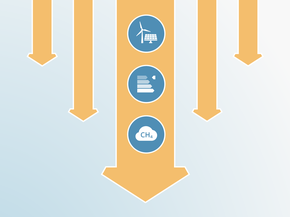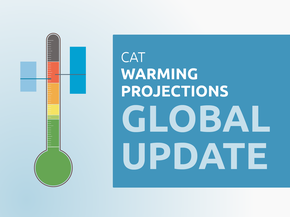Assumptions
Historical emissions
Historical emissions from 1990 to 2023 are taken from PRIMAP series v2.6 (Gütschow et al., 2024).
NDC
Business-as-usual scenario
Egypt’s updated NDC target is expressed as a reduction below a business-as-usual (BAU) scenario. The NDC provides 2030 BAU values for the electricity, transport, and oil and fossil gas sub-sectors only. For energy-related CO₂ emissions outside these sub-sectors, as well as for other sectors, we estimated 2030 BAU values by extrapolating the average annual growth trend observed over 2005–2015 to the 2015 baseline year reported in Egypt’s First Biennial Update Report (BUR1). This represents a methodological change from relying on external reference scenarios, as it ensures consistency with Egypt’s own reported data and provides a more transparent, data-driven basis for extrapolation. As the NDC covers only CO₂, CH₄, and N₂O, we used F-gas data from PRIMAP version 2.0 and extrapolated post-2015 values to 2030 based on the 2005–2015 trend.
Conditional NDC target
We have used the reductions in Egypt’s 2023 NDC for the electricity, transport and oil & fossil gas sectors. These reductions represent the upper end of the conditional NDC quantification. For the lower end of the range, we also estimated emissions reductions from the industry and buildings sectors.
Egypt’s NDC refers to the Low-Carbon Roadmap for Egypt’s Cement Sector, which targets a 15% reduction in CO2 emissions from the cement sector. As cement represents a large share of Egypt’s CO2 emissions in the industry sector, we have assumed this reduction applies to the entire sector and subtracted it from our industry BAU (IRENA’s reference scenario for industry) (IRENA, 2018). For the buildings sector, we have assumed an 8% reduction below IRENA’s reference scenario, in line with the reduction in non-renewable energy use between 2015 and 2030 in IRENA’s enhanced renewable energy (REMap) scenario compared to the reference one in 2030.
Current policy projections
We derive the range of projections under current policies according to the following method:
- Lower end of the range: Historical data shows that per capita emissions have been largely stable in the past. We assume this correlation continues and apply the average per capita emissions to UN population projections until 2035. We take a 10-year average per capita emissions ratio, apply an emissions growth rate that follows the population trend, and harmonise the result with the latest historical year provided in PRIMAP.
- Upper end of the range: We use the Reference Scenario 2 (RS2) projections from Abdelmeguid and Ibrahiem (2025), based on the LEAP modelling tool, to estimate energy-related CO₂ emissions. For CO₂ emissions from other sectors, we assume a continuation of the pre-COVID five-year historical trends until 2035, based on PRIMAP data (Gütschow et al., 2024). For non-CO₂ emissions, we apply growth rates to the latest historical year using the most recent projections from the U.S. Environmental Protection (2025). We selected RS2 scenario since it represents the most probable trajectory for Egypt’s energy sector, given the country’s slow progress in expanding renewable energy capacity to meet rising electricity demand. The scenario accounts for increased energy demand, continued reliance on oil and fossil gas, and the planned addition of 4.8 GW of nuclear capacity from the El Dabaa Nuclear Power Plant, which is currently under construction (while RS1 assumes no nuclear development). RS2 does not cap emissions or limit renewable energy growth, but it projects renewables reaching 30% of electricity generation by 2030 and 37% by 2035, which is well below Egypt’s NDC target of 42% by 2030. This outlook is fairly consistent with recent developments (see Policies and action).
Global Warming Potentials values
As of June 2025, CAT has begun presenting its figures and time series using Global Warming Potential (GWP) values from the IPCC Fifth Assessment Report (AR5).
Further analysis
Latest publications
Stay informed
Subscribe to our newsletter




